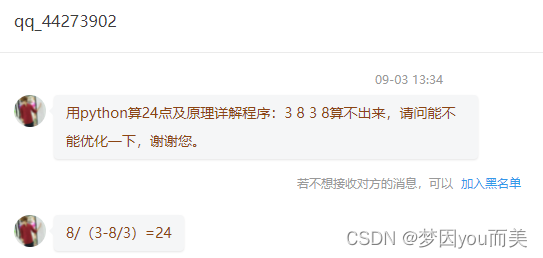用python算24点及原理详解 |
您所在的位置:网站首页 › 27710算24点三种方法 › 用python算24点及原理详解 |
用python算24点及原理详解
|
1 描述
给出4个正整数,使用加、减、乘、除4种运算以及括号把4个数连接起来得到一个结果等于24的表达式。 注:这里加、减、乘、除以及括号的运算结果和运算优先级跟平常定义一致。 例如,对于5,5,5,1,可知 5× (5-1/5) = 24。又如,对于 1,1,4,2 无论如何都不能得到24 1.1 输入格式在代码中的输入部分输入4个正整数。 1.2 输出格式对于每一组测试数据,如果可以得到24,输出"YES"其算法;否则输出“NO”。 2 大致思路将四个数字进行全排列,在他们之间添加运算符号,最后将数字和操作符进行拼接运算。 运算符我们需要进行排列组合,因为只有四个数字,所以只需要三个运算符,而且算法符可能会重复,比如三个都是+。 再遍历四个数字的全排列,对每一组数字而言,遍历所有组合的操作符。最后将数字和操作符进行拼接运算,就可以得到最终结果了。 3 知识点补充1、首先我们对所有数字进行去全排列,这里我们使用 itertools.permutations 来帮助我们完成。 iertools.permutations 用法演示 import itertools a = int(input("请输入第1个数字:")) b = int(input("请输入第2个数字:")) c = int(input("请输入第3个数字:")) d = int(input("请输入第4个数字:")) my_list = [a, b, c, d] result = [c for c in itertools.permutations(my_list, 4)] for i, r in enumerate(result): if i % 4 == 0: print() print(r, end="\t") print("\n\n长度为:", len(result))运行结果: 请输入第1个数字:1 请输入第2个数字:2 请输入第3个数字:3 请输入第4个数字:4 (1, 2, 3, 4) (1, 2, 4, 3) (1, 3, 2, 4) (1, 3, 4, 2) (1, 4, 2, 3) (1, 4, 3, 2) (2, 1, 3, 4) (2, 1, 4, 3) (2, 3, 1, 4) (2, 3, 4, 1) (2, 4, 1, 3) (2, 4, 3, 1) (3, 1, 2, 4) (3, 1, 4, 2) (3, 2, 1, 4) (3, 2, 4, 1) (3, 4, 1, 2) (3, 4, 2, 1) (4, 1, 2, 3) (4, 1, 3, 2) (4, 2, 1, 3) (4, 2, 3, 1) (4, 3, 1, 2) (4, 3, 2, 1) 长度为: 24 4 具体代码 from itertools import permutations a = int(input("请输入第1个数字:")) b = int(input("请输入第2个数字:")) c = int(input("请输入第3个数字:")) d = int(input("请输入第4个数字:")) my_list = [a, b, c, d] # 对4个整数随机排列的列表 result = [c for c in permutations(my_list, 4)] symbols = ["+", "-", "*", "/"] list2 = [] # 算出24的排列组合的列表 flag = False for one, two, three, four in result: for s1 in symbols: for s2 in symbols: for s3 in symbols: if s1 + s2 + s3 == "+++" or s1 + s2 + s3 == "***": express = ["{0}{1}{2}{3}{4}{5}{6}".format(one, s1, two, s2, three, s3, four)] # 全加或者乘时,括号已经没有意义。 else: express = ["(({0}{1}{2}){3}{4}){5}{6}".format(one, s1, two, s2, three, s3, four), "({0}{1}{2}){3}({4}{5}{6})".format(one, s1, two, s2, three, s3, four), "(({0}{1}({2}{3}{4})){5}{6})".format(one, s1, two, s2, three, s3, four), "{0}{1}(({2}{3}{4}){5}{6})".format(one, s1, two, s2, three, s3, four), "{0}{1}({2}{3}({4}{5}{6}))".format(one, s1, two, s2, three, s3, four)] for e in express: try: if eval(e) == 24: list2.append(e) flag = True except ZeroDivisionError: pass list3 = set(list2) # 去除重复项 for c in list3: print("YES:", c) if not flag: print("NO!") 5 BUG修复感谢qq_44273902博主提出程序BUG,现进行BUG修复 输入3、3、8、8,进行问题复现
输出结果如下:
针对输出结果进行分析,明明是有正确答案的,为何还输出NO!??? 5.1.2 原因分析运行以下代码流程 print(8/(3-(8/3)))运行结果:
了然,精度问题 5.2 针对问题进行解决既然是由于精度问题造成的,那么可以约定保留6位小数点(当然也可以保留其他位数的小数),如此一来即可解决该问题。 将第36行代码 if eval(e) == 24: 改成 if round(eval(e), 6) == 24: 优化之后的代码如下: from itertools import permutations a = int(input("请输入第1个数字:")) b = int(input("请输入第2个数字:")) c = int(input("请输入第3个数字:")) d = int(input("请输入第4个数字:")) my_list = [a, b, c, d] # 对4个整数随机排列的列表 result = [c for c in permutations(my_list, 4)] symbols = ["+", "-", "*", "/"] list2 = [] # 算出24的排列组合的列表 flag = False print(result) for one, two, three, four in result: for s1 in symbols: for s2 in symbols: for s3 in symbols: if s1 + s2 + s3 == "+++" or s1 + s2 + s3 == "***": express = ["{0}{1}{2}{3}{4}{5}{6}".format(one, s1, two, s2, three, s3, four)] # 全加或者乘时,括号已经没有意义。 else: express = ["(({0}{1}{2}){3}{4}){5}{6}".format(one, s1, two, s2, three, s3, four), "({0}{1}{2}){3}({4}{5}{6})".format(one, s1, two, s2, three, s3, four), "(({0}{1}({2}{3}{4})){5}{6})".format(one, s1, two, s2, three, s3, four), "{0}{1}(({2}{3}{4}){5}{6})".format(one, s1, two, s2, three, s3, four), "{0}{1}({2}{3}({4}{5}{6}))".format(one, s1, two, s2, three, s3, four)] # print(one + two + three + four) if str(one) + str(two) + str(three) + str(four) == "8383": print(express) for e in express: try: # if eval(e) == 24: if round(eval(e), 6) == 24: list2.append(e) flag = True except ZeroDivisionError: pass list3 = set(list2) # 去除重复项 for c in list3: print("YES:", c) if not flag: print("NO!") |
【本文地址】
今日新闻 |
推荐新闻 |



